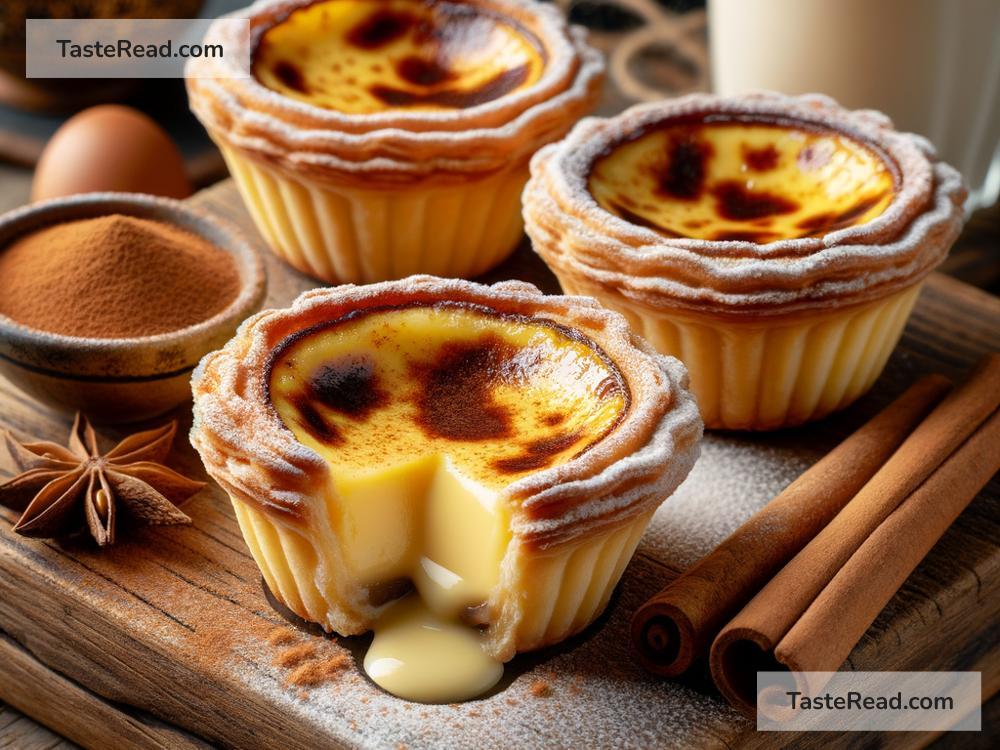Delight in Every Bite: Crafting Authentic Portuguese Pastéis de Nata at Home
Portuguese Pastéis de Nata, a gem in the world of pastries, have won hearts worldwide with their sublime taste. These small, creamy custard tarts encased in crispy pastry are the pride of Portuguese confectionery, having originated from the Jerónimos Monastery in Belém, Lisbon, in the 18th century. Since then, they have traversed borders to capture the imagination and taste buds of dessert lovers everywhere. Here’s how you can recreate the magic of authentic Portuguese Pastéis de Nata in your kitchen, even if you’re miles away from Portugal.
Ingredient Line-up
The beauty of Pastéis de Nata lies in their simplicity. Here’s what you need:
- For the Pastry:
- 1 cup (250ml) of water
- A pinch of salt
- 2 cups (250g) of all-purpose flour, plus extra for dusting
-
1 cup (225g) of unsalted butter, room temperature
-
For the Custard:
- 1 tablespoon of cornstarch
- 1 ½ cups (355ml) of whole milk
- 1 cup (225g) of granulated sugar
- 1 cinnamon stick
- 1 whole lemon peel (make sure to avoid the white part as it’s bitter)
- 6 large egg yolks
Preparing Your Masterpiece
Step 1: Crafting the Pastry
- Start by dissolving the pinch of salt in water.
- In a large bowl, mix the flour with water using a fork until a dough starts to form. If it’s too sticky, add a little more flour.
- Transfer the dough to a floured surface and knead it until smooth. Let it rest for about 10 minutes.
- Roll out the dough into a rectangle, spread one-third of the softened butter over two-thirds of the rectangle, leaving a margin at the edges.
- Fold the unbuttered third over the middle third, and then fold the other side on top (like a letter). Turn it 90 degrees, and roll it out again. Repeat this process twice, each time with one-third of the butter. This creates the layers that will give the pastry its flakiness.
- After the final fold, refrigerate it for at least 30 minutes.
Step 2: The Custard Quest
- In a small bowl, dissolve the cornstarch in ¼ cup of milk. Set aside.
- Combine the remaining milk, sugar, cinnamon stick, and lemon peel in a saucepan. Bring it to a boil, then remove it from the heat and let it infuse for a few minutes.
- In a bowl, whisk the egg yolks with the cornstarch mixture. Gradually whisk in the hot milk to temper the eggs.
- Return the mixture to the saucepan, and stir constantly over low heat until it thickens (but do not let it boil).
- Remove from heat and strain to remove the cinnamon stick and lemon peel. Let it cool.
Step 3: Assembling and Baking
- Preheat your oven to 550˚F (285˚C), or as high as it goes if it doesn’t reach that temperature.
- On a floured surface, roll out the pastry dough into a thin sheet, then roll it up into a tight log. Cut this log into 1-inch pieces.
- Place each piece into a muffin tin slot, and use your thumbs to press and stretch the dough up the sides, creating thin, even layers.
- Spoon the custard into each pastry case, filling them about ¾ full.
- Bake in the preheated oven for about 10-12 minutes or until the pastry is crisp and the tops start to blister and blacken in spots.
- Cool the tarts in the pan for 5 minutes, then transfer them to a rack to cool slightly.
The Art of Serving
Pastéis de Nata are best enjoyed freshly baked, slightly warm with a dusting of cinnamon or powdered sugar on top. Pair it with a strong coffee for an authentic Lisbon café experience.
Culinary Adventure Awaits
Making Pastéis de Nata might seem like a challenge, but it’s a rewarding one. It’s not just about following the recipe; it’s about embracing the joy of creating something traditional and utterly delicious. Each bite transports you to the narrow, charming streets of Lisbon, where these tarts continue to be a symbol of Portuguese culinary heritage. So, don your apron, and let the aroma of baking Pastéis de Nata fill your home and your heart. Who knows? With a little practice, you might just craft a tart that could rival those from the famed Pastéis de Belém bakery. Happy baking!


